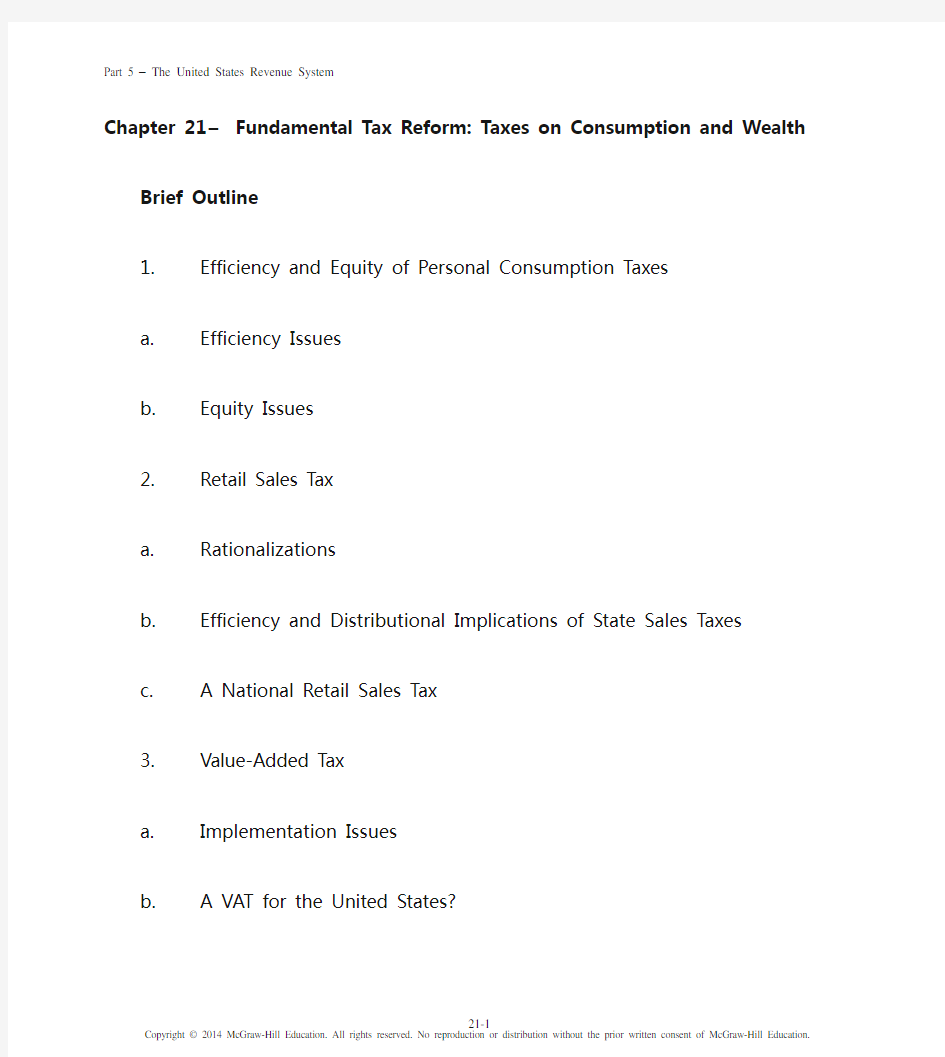财政第十版课后答案21

- 1、下载文档前请自行甄别文档内容的完整性,平台不提供额外的编辑、内容补充、找答案等附加服务。
- 2、"仅部分预览"的文档,不可在线预览部分如存在完整性等问题,可反馈申请退款(可完整预览的文档不适用该条件!)。
- 3、如文档侵犯您的权益,请联系客服反馈,我们会尽快为您处理(人工客服工作时间:9:00-18:30)。
Part 5 – The United States Revenue System
Copyright © 2014 McGraw-Hill Education. All rights reserved. No reproduction or distribution without the prior written consent of McGraw-Hill
Education. 21-1
Chapter 21 – Fundamental Tax Reform: Taxes on Consumption and Wealth
Brief Outline
1. Efficiency and Equity of Personal Consumption Taxes
a. Efficiency Issues
b. Equity Issues
2. Retail Sales Tax
a. Rationalizations
b. Efficiency and Distributional Implications of State Sales Taxes
c. A National Retail Sales Tax
3. Value-Added Tax
a. Implementation Issues
b. A VAT for the United States?
4. Hall-Rabushka Flat Tax
5. Cash-Flow Tax
6. Income versus Consumption Taxation
a. Advantages of a Consumption Tax
b. Disadvantages of a Consumption Tax
c. Problems with Both Systems
7. Wealth Taxes
8. Estate and Gift Taxes
a. Rationales
b. Provisions
c. Reforming Estate and Gift Taxes
9. Prospects for Fundamental Tax Reform
Suggested Answers to the End of Chapter Questions
1.
a. The income tax is 50 percent, so Zach pays 50%*$10000 = $5000 in income taxes
in the first period. He saves half of what is left after taxes and earns 10%,
therefore he saves $2,500 and earns $250 in interest, but pays half of that interest,
$125, in taxes. The present value of his lifetime tax payments is $5000 +
$125/1.1 = $5113.64
b. In the second period, Zach has savings and interest equal to $2750. He will use
all this savings on consuming and paying consumption taxes. He will pay $1375
in consumption taxes, so the present value of his tax payments is now $5000 +
1375/1.1 = $6247.73
These calculations demonstrate the transitional problem in moving to a
consumption tax because Zach had to pay high taxes during period 1 when he
earned most of his income, and then had to pay high taxes during period 2 when
he did his consuming.
2. The burden of the estate tax includes the resources used in estate planning and the effects
of estate planning. Many families may alter their behavior in reaction to the estate tax
Chapter 21 – Fundamental Tax Reform: Taxes on Consumption and Wealth
Copyright © 2014 McGraw-Hill Education. All rights reserved. No reproduction or distribution without the prior written consent of McGraw-Hill
Education.
21-2 and, if this results in less efficiency, the estate tax creates an excess burden that is not reflected by the number of taxable estates or the amount of tax revenue collected.
3. There is a fundamental confusion here. There is no reason to assume that the incidence
of a general consumption tax (a VAT) will be the same as the incidence of a partial factor tax (corporate income tax).
4.
a. For a fan giving a million-dollar ball to McGwire or Sosa, there would be a
federal gift tax liability. The person receiving the gift owes no tax.
b. If the fan keeps the ball, the fan would owe no tax now. But the ball would
become part of his or her estate, taxable after death under the estate tax.
c. The fan can avoid tax entirely by giving the ball to a charity, since he could
entirely deduct the value of the ball from his taxable income. The charity could
sell the ball; the proceeds from the sale would not be taxed.
d. If the fan sells the ball, the fan owes tax on the net proceeds, just as the seller of
any property would. The transaction would put the fan in the highest tax bracket,
so that the marginal tax rate on the proceeds would be 35 percent.
e. If the fan holds onto the ball for a year, it becomes a long-term capital asset,
subject to the maximum capital-gains tax rate of 28 percent. Unless the fan thinks
that there is going to be a substantial drop in the market value of the ball, he or
she should hold onto it for a year.
5. The efficiency of this tax seems to be good because it would not change incentives.
However, it does increase the likelihood that the government will do it again, as it was done once.
6. Bradford was right. In the simplest possible case, the budget constraint is pC = wH,
where p is the price of consumption, C is units of consumption, w is the wage rate, and H is hours of work. With an income tax, pC=(1-t)wH, where t=income tax rate. With a consumption tax, (1+τ)pC=wH, where τ=consumption tax rate. Thus, for any income tax rate t, we can find a consumption tax rate, τ, that is equivalent by solving the expression: (1+τ)=1/(1-t).
7.
a. We can conclude that an income tax generates an excess burden if it creates a tax
wedge between the amount a borrower pays and the amount a lender receives.
With a 25% income tax and an interest rate of 8%, lenders receive (1 – t)r = 6%.
Since interest paid is tax deductible, borrowers pay (1 – t)r = 6%. Therefore,
there is no tax wedge and no excess burden.
b. If interest payments are not tax deductible, then borrowers pay 8%, while lenders
receive 6% after taxes. Since there is a wedge between the two rates, the income
tax creates an excess burden in this case.
